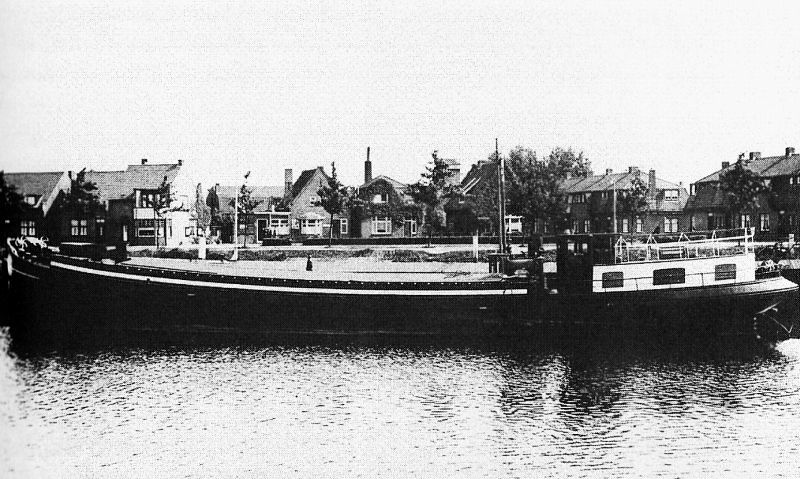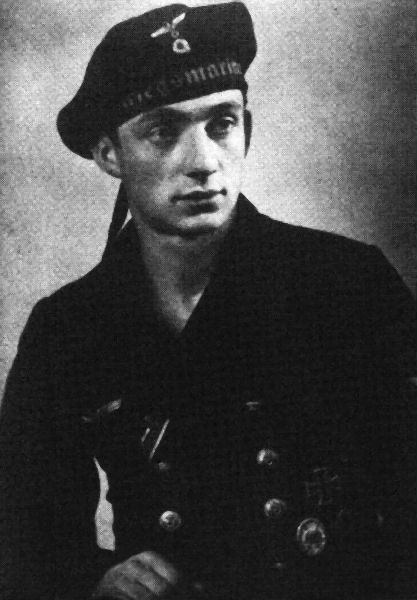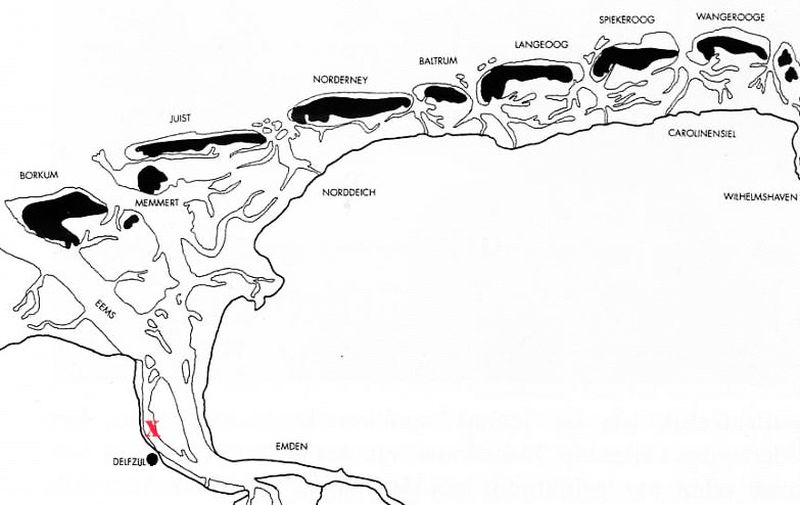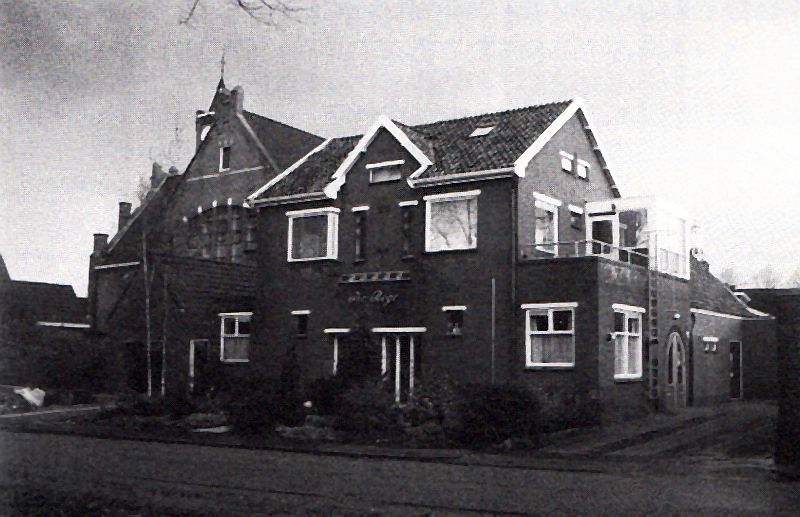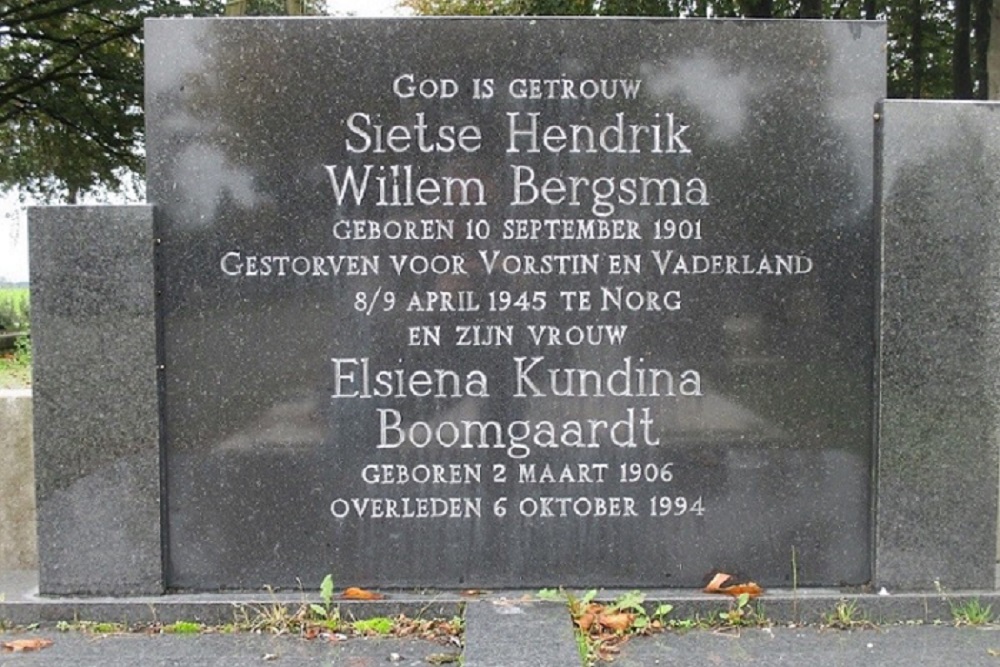Introduction
After the devastating air raid on Wangerooge of 25 April 1945, the Dutch surviving forced labourers wanted to go home as soon as possible. The first days after the raid sporadic anti aircraft fire was heard. After that it remained silent. From 5 May on the heavy thud of the shelling on main land Germany had stopped. The attitude of the guards towards the German speaking Dutch became more communicative and in this way they heard of Germany's surrender on 5 May 1945. This only increased the desire to get home. A handful of Dutch had walked to the harbour at Westanleger which was quite far from the central village of Wangerooge, via the narrow gauge rail. They hoped to find a ship that could bring them home.
There were some ships in the Westanleger. They were the Dutch coasters Lelie and Noordster, the barge Joanna and the tanker Macedonia. The Noordster had sustained some damage to the hull which was repaired in an improvised way with tarpaulin and beams. The ship was not able to sail independently however. Therefore the captains of the Noordster and the Lelie had decided to join both ships together and fix them in place with mooring ropes. In this way it was assumed that the tarpaulin cover would hold.While they were still busy with this, they were confronted with groups of forced labourers from Holland. Mrs.J.Westers-Dost, wife of the captain and owner of the Lelie, remembers: "They asked if they could travel along to Holland.We were willing to help them but how were we supposed to do that? We still had some cargo in the hold.The damaged Noordster lay alongside.It would be a difficult journey anyway.We did not know how the Noordster would hold. How could we manage this in a safe way? If anything were to go wrong we had so many untrained sailors on board. It was a huge problem."
The presence of large numbers of forced labourers was not new to the crew of the Lelie. In the past years the ship, loaded with building materials, had visited the port of the island several times. On all East Frisian islands there were forced labourers and the crew knew that these were treated differently according to their nationality.If they got the chance they would give the prisoners some water or food or would take post with them.Mrs. Westers-Dost: " These people looked very dirty all the time.Don't forget the tremendous pressure under which they had to work. Their housing and plumbing was probably inadequate.We gave them some buckets of water so that they could refresh themselves. They were terribly hungry. Sometimes we managed to give them some of our food."
Definitielijst
- raid
- Fast military raid in enemy territory
- shelling
- Indication for shooting targets with grenades. Both from artillery and armoured artillery.
Images
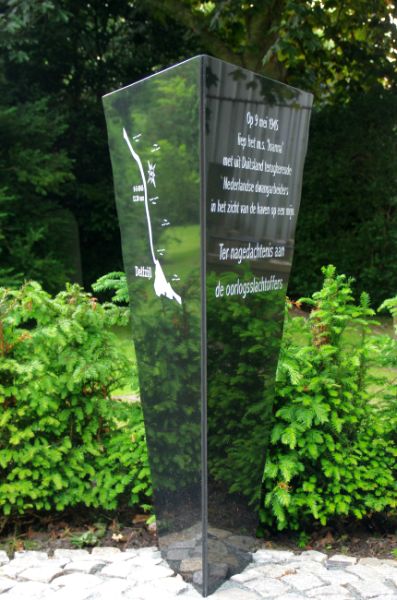 Monument in Delfzijl in memory of the war victims of the Joanna, 9 May 1945. Source: Staat in Eemsdelta.
Monument in Delfzijl in memory of the war victims of the Joanna, 9 May 1945. Source: Staat in Eemsdelta.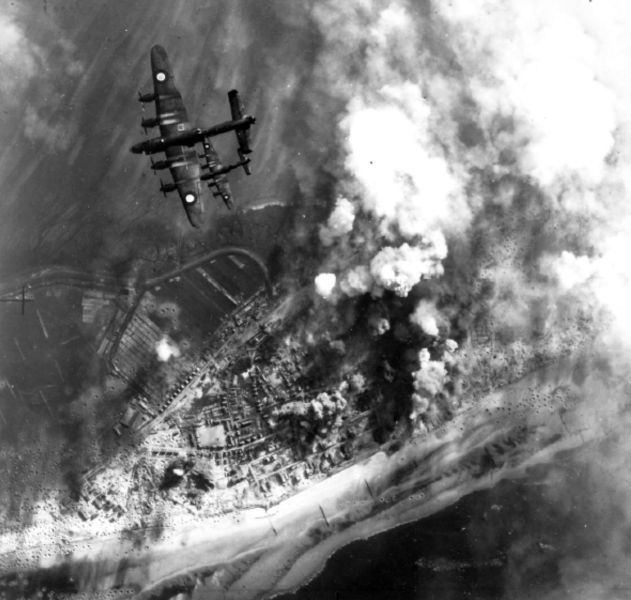 Air raid on Wangerooge, 25 April 1945. Source: Wikipedia.
Air raid on Wangerooge, 25 April 1945. Source: Wikipedia.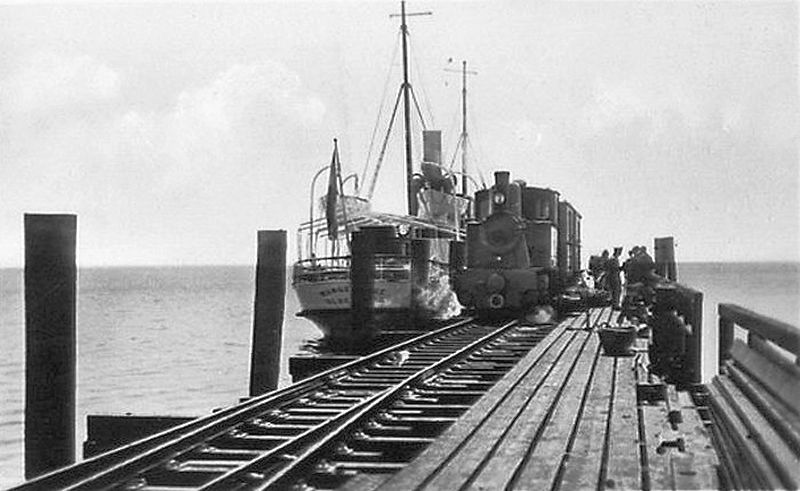 Westanleger, the little harbour of Wangerooge with the narrow-gauge railway. Source: Insel Rundgang.
Westanleger, the little harbour of Wangerooge with the narrow-gauge railway. Source: Insel Rundgang.The Joanna and captain Baumeister
Mrs. Westers-Dost: "The captain of the barge behind us then solved the problem .He said that his ship was in good working order and that the engine was fine." "Let them come on board and I will bring them to Delfzijl". I can not remember the man accurately but I know that he was a nice man to speak to. The mentioned ship was the Joanna. It was a Dutch barge that had been requisitioned by the German authorities and that was equipped with a German six man crew. The freighter of 273 tonnes had as its original home-port Sliedrecht. In German service her home-port was the German city of Emden on the Ems.
The captain who had just said these words had just turned twenty four years old. He was the Oberbootsmann of the Kriegsmarine Heinz Werner Baumeister. In 1939, then 19 years old, Baumeister was drafted and was placed into the Kriegsmarine. He received his basic training at the German naval base of Wilhelmshaven. After this he was trained as a seaman and gunner on board of destroyers.After his first war experiences on board of a sort of landing craft on the Black Sea, he was wounded during a Soviet air raid and after recovering he was transferred to France in a unit of mobile patients, a so called Genesendeneinheit or "unit of convalescing people". Here he was put in charge of a requisitioned French barge with five other crew members. After the allied break out from Normandy he was ordered to blow up the ship and its contents.At that moment the barge was loaded with ammunition. "I could not get myself to comply with this order." says Baumeister. "I put my men ashore and ran the boat some distance from shore. Then I scuttled the boat and swam back to the shore. The ship sank and it could not be used, which I figured was enough." His superiors, however, thought differently and thought he had obstructed an order. He was court-martialled and degraded to corporal and placed in a penal battalion.
A short time after this transfer Baumeister was wounded again and found himself convalescing in the Erasmus Gymnasium in Rotterdam. Possibly due to a lack of skilled personnel, he received command of a barge again after full recovery.Besides he was restored in his old rank of Oberbootsmann.In this way the young non- commissioned officer returned to Emden where he became captain of the Joanna. Baumeister: "We sailed for the Organisation Todt with all kind of cargoes. Mainly, however, the cargo was building material like cement, parts of bridges, machines and other equipment. The Dutch destination was mostly Rotterdam and Amsterdam. We left the Netherlands through Delfzijl."
With the allied advance in April,1945, through the Netherlands and Germany being unstoppeable, Baumeister received the order to evade to Wilhelmshaven. The Joanna ran aground near the East Frisian island of Spiekeroog. The ship got afloat again with the high tide and headed to Wangerooge. The next day a liaison officer reported that Germany had surrendered and that every action of German military was forbidden pending new orders from the allies.
Mr. Baumeister: "We were in the cabin in the evening when we heard cluttering on deck.They turned out to be Dutch and they were visibly frightened when they saw our German uniforms. They explained that they were prisoners from the camp on the island and that they had expected a Dutch crew. They had had a bad time behind them and they wanted to go home. Dirty and shabby they stood there and one could almost feel their disappointment. Very clearly I felt that I might be the solution for these people's problem.I proposed to my crew to bring these people and their comrades to Holland. The Dutch in their turn offered to say a good word for us and provide temporary shelter. But my men would have none of this. No way they wanted to go to Holland. I could do whatever I liked as long as I would drop them somewhere on German shore. In this way we reached an agreement." Captain Baumeister decided to adapt the name of the Dutch captain of the Joanna and so Oberbootsmann Baumeister became kapitein Piet Visser from Sliedrecht.
Definitielijst
- Kriegsmarine
- Germa navy. Part of the Wehrmacht next to Heer and Luftwaffe.
- raid
- Fast military raid in enemy territory
Images
Departure of Wangerooge
That same evening,on 6 May1945, the first groups of Dutch who wanted to go to Holland with the Joanna arrived.During the night and the early morning of 7 May, more Dutch came on board. That same morning at high tide, the Joanna and the Macedonia left for Holland. On board of the tanker were also some former foreign labourers. For them, leaving behind Wangerooge was the beginning of a new era. The memories from life on the island were etched in their minds indelibly. Memories of a forced stay, of long, heavy days of building bunkers, of scant food, bad clothing and lack of good shoes. On top of this came the trauma of the heavy bombing. Now there was the common desire of going home.
In the harbour of the island of Langeoog passengers were exchanged.They grouped according to city or region of birth and mutual bonds. In the afternoon, the journey was continued, but after a while the ships got stuck on the Shallows that were running dry. The joined coasters Joanna and Lelie had left the same morning from Wangerooge and ran aground at the same time as the Joanna and the Macedonia.The coasters got unstuck after some time, but the Joanna could continue her voyage only the next morning.The Macedonia remained stuck until Thursday 10 May. The Joanna reached the fishing village of Norddeich on the German shore first. Here the German crew was landed according to the agreement. With 46 souls on board the journey was continued in the morning of 9 May 1945.
The journey was going fine and Delfzijl would be reached in a few hours. The weather was exceptionally beautiful and around noon the passengers and crew of the Joanna spotted ,ahead of them, the joined coasters Lelie and Noordster that sailed at a slow pace towards Delfzijl.On board of the Joanna the passengers had taken it easy and were enjoying the slow passing coast line of Groningen. After long and terrible years the final liberation came slowly, but surely, in sight.Mr. Baumeister alias Visser: "The men were in the cabin, others were on the hatches and some others must have been in the hold. If I remember well, there was singing and someone played harmonica. One of the people, whose name I do not recollect, was more or less an assistant of mine; another one kept an eye on the engine room. Twice an airplane flew over. When we reached the Dutch coast I asked my assistant to take over the rudder for a while. The rudder chain had run off the quadrant. This had happened before and I could solve it in no time."
Definitielijst
- mine
- An object filled with explosives, equipped with detonator which is activated by either remote control or by colliding with the targeted object. Mines are intended to destroy of damage vehicles, aircrafts or vessels, or to injure, kill or otherwise putting staff out of action. It is also possible to deny enemy access of a specific area by laying mines.
Images
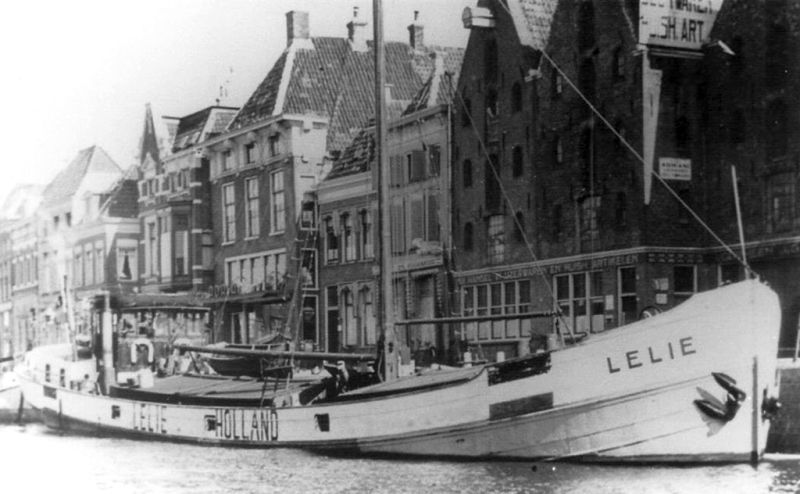 The Dutch coaster Lelie in Groningen, 1931. Source: Shipspotters.
The Dutch coaster Lelie in Groningen, 1931. Source: Shipspotters.Ship disaster with the Joanna
Kapitein Baumeister handed over the rudder, walked to the rear of the ship and lifted the iron entry hatch to the engine room. At that moment an enormous explosion sounded and a pressure wave ran through the ship . The Joanna had run into a mine. Kapitein Baumeister: "A giant shock wave blew me off the ship. I landed in the water and when I emerged, I saw the stern of the Joanna that sank. Everywhere there were people afloat and everyone was crying for help. I managed to push some wood wreck towards them to which they could clamp. But many of them were injured and did not have the strength to hold on.Besides,the water was very cold and the former labourers were in a bad overall condition. The group became rapidly smaller and the current swept us farther out of each other."
Mrs. Westers-Dost, on board the Lelie, witnessed the disaster that took place behind the joined coasters : "It was a terrible bang and I ran upstairs.It was horrible what I saw, these poor people. When I got upstairs I saw the Joanna was sinking. I saw the bow of the Joanna, she had a winch and a small davit there. When the bow disappeared slanting under the surface of the water, also the stern disappeared. The entire midship must have been ripped away by the explosion.The hatches were torn off and everywhere you could see people that tried to keep their heads above the water. And there was a lot of blood. It was a horrible situation." The Lelie as well as the Noordster dropped their anchors and on board of the Lelie a sloop was lowered.With the aid of the outgoing ebb stream the crew of the Lelie and the Noordster rowed to the place of the disaster. What they encountered there was beyond description. Around them people shouted and drowned amidst the flotsam and jetsam, the blood and the mutilated corpses. Aware of their impotence in this overwhelming disastrous situation the men tried blindly to save anyone they could. They managed to pull some people on board of their sloop and at the moment that they were overcome by exhaustion and emotions a second sloop appeared on the scene of the disaster.
The second sloop, crewed by three fishing men, came from the hamlet Nieuwstad behind the dyke.The three had looked on interested at the three passing ships. One of the fishing men: "We saw the ships coming. Two coasters in front and a barge behind. We looked on interested because we had not seen shipping for a long time in this part of the sea. We knew nothing about mines. And while we were watching there was this huge bang and at the same time the rear ship was gone. Completely gone.There still was a giant column of water, like a very high iceberg, but nothing besides that.Then the shouts for help began. At the dyke we had our sloops ready that lay on anchors and that we used for fishing on the Ems. I pulled off my pants and went into the water to the boats. It cost some trouble and time to reach the boat, for it was high tide and the water was up to my middle. I remembered that I swore:"Why don't the people on the coasters lower their sloops". It took some time before we arrived at the place of the disaster for there was a strong current. The sailors from the coasters were spent. They were so tired and desperate that they were trembling all over their bodies. They had saved three men in the sloop and a few were clinging unto the sloop. We managed to get these on board and we also took over the three others. Then we had to get ashore again but with all the people in the boat rowing was difficult. The ebb stream put us ashore somewhere past the Eemscentrale, the Ems power station. Seven men we brought ashore. Later we learned that 46 persons had been on board. It was a terrible disaster."
The exhausted men in the sloop of the Lelie could not reach their ship on their own power. On board of the coasters a piece of drift-wood with a long line was put over board.In this way the sloop was pulled against the stream towards the joined coasters. In the overloaded sloop of the fishing men kapitein Baumeister helped rowing in order to counter any undercooling. Stumbling and mutually supporting, the rescuers and the rescued reached a remote house where first aid was given. A neighbour brought a bottle of booze that he had saved in order to celebrate the liberation. That had not come yet, but the booze helped the people to recover somewhat. A neighbour kid was sent by bicycle in order to fetch a doctor because there were two seriously injured among the group.The doctor diagnosed one with a broken clavicle and lacking a proper ambulance he was dispatched by horse and wagon to the Academic Hospital in Groningen. The other six rescued, among whom the lightly injured person, were transferred to the village of Spijk and were quartered in the hall Pro Rege.
Definitielijst
- mine
- An object filled with explosives, equipped with detonator which is activated by either remote control or by colliding with the targeted object. Mines are intended to destroy of damage vehicles, aircrafts or vessels, or to injure, kill or otherwise putting staff out of action. It is also possible to deny enemy access of a specific area by laying mines.
Images
Conclusion
The Koninklijke Marechaussee, the Dutch Military Police, in Groningen drew up a list of the 39 victims. Some of the rescued stayed longer in Groningen in order to help identifying the bodies that would wash ashore. All succumbed of the disaster with the Joanna were buried in Delfzijl. On request of relatives some of them were later reinterred in their living place or in their places of birth.
Kapitein Baumeister ran into problems because of the disaster. In order not to be detained as a German POW in the Netherlands he kept his false identity, but was quickly unmasked by a ship's charterer. The German NCO with his good intentions was put in prison in Groningen.After a few weeks and interrogations he was placed in camp Westerbork in Drenthe. He managed to escape and walked back to his elderly home in Westphalia, where he arrived in September,1945.
The wreck of the Joanna, which was marked by a buoy was an obstacle for shipping in the waterway for some time. The salvaging of the wreck took some years. The demand for salvaging material was very big in post war Holland and the Joanna was given little priority.Only in 1947 did salvaging material become available.This was in the form of a floating derrick of Tak`s Bergings Maatschappij at Rotterdam. The parts of the wreckage were put on a shallow place near the harbour's mouth, outside the dykes.
After the Macedonia got loose from the Shallows the ship was ordered to travel to the island of Norderney and after that to Norddeich because of the mine explosion in the waterway to Delfzijl. On 10 May the German fishing port was reached and the Canadians took care of the former forced labourers.After a few days they were brought to the Netherlands by Canadian military vehicles.
On 8 May, 2013 a monument was revealed in Delfzijl with the text; "Joanna 9 May, 39 victims of war in peace time’. The monument in de shape of a ship's bow is an initiative of the Werkgroep 4 mei and the municipality of Delfzijl. They got the idea for the monument after the release of the book "Scheepsramp Joanna" from Hans Beukema which also is the main source for this article and "Air raid on Wangerooge".
Definitielijst
- mine
- An object filled with explosives, equipped with detonator which is activated by either remote control or by colliding with the targeted object. Mines are intended to destroy of damage vehicles, aircrafts or vessels, or to injure, kill or otherwise putting staff out of action. It is also possible to deny enemy access of a specific area by laying mines.
- POW
- Prisoner of War.
- raid
- Fast military raid in enemy territory
Images
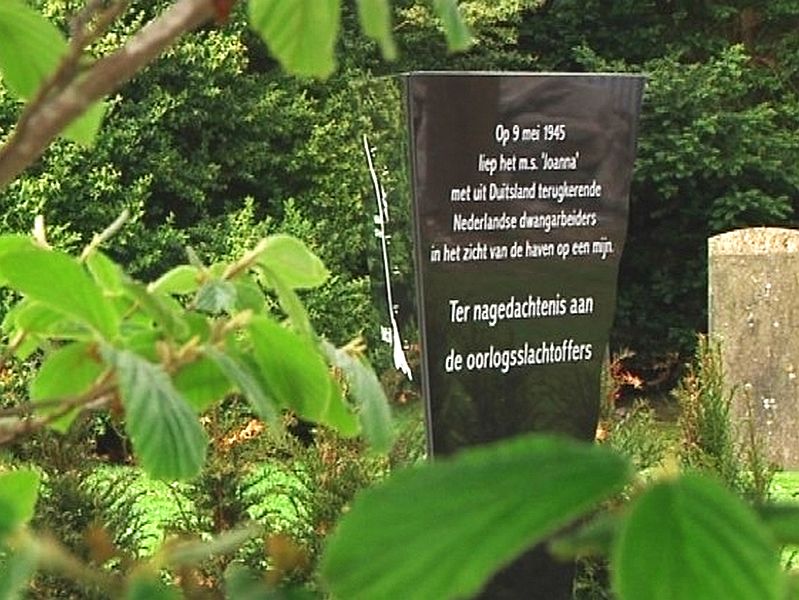 Monument in memory of the war victims on the Ems in peace time. Source: Rtvnoord.
Monument in memory of the war victims on the Ems in peace time. Source: Rtvnoord.Information
- Article by:
- Peter Kimenai
- Article by:
- Peter ter Haar
- Published on:
- 28-05-2015
- Last edit on:
- 30-09-2024
- Feedback?
- Send it!
